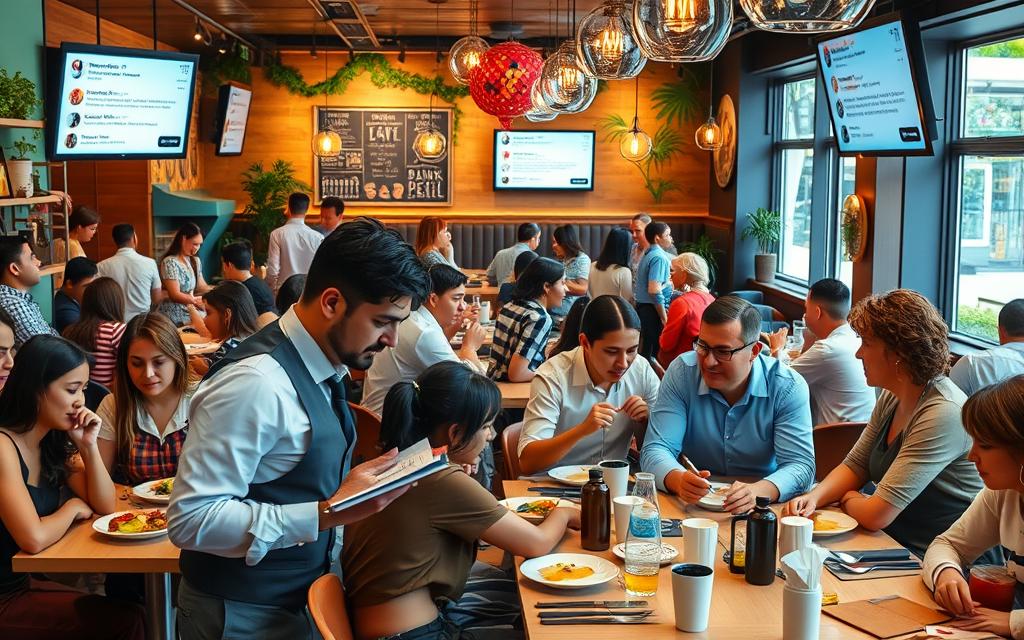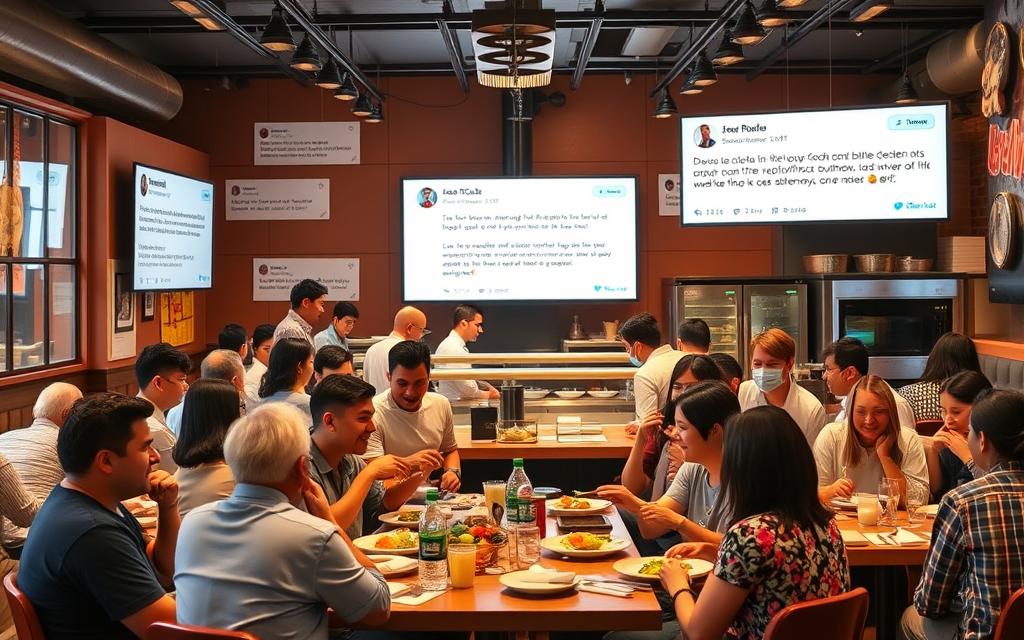In today’s world, online reviews and social media greatly affect what customers choose. Restaurants must actively manage their online image. With more negative reviews appearing, it’s vital to take charge of your reputation. This means knowing where you stand now and understanding what people think of you.
Start by using surveys, questionnaires, and focus groups to see how people view your restaurant. Next, figure out what threats could harm your reputation. Lastly, know where you want to be in terms of reputation.
Key Takeaways
- Proactive reputation management is crucial for restaurants in the digital age.
- Assessing your current reputation and identifying potential risks are essential first steps.
- Developing strategies to close the gaps between your current and desired reputation is key.
- Monitoring online mentions and responding quickly to manage your reputation effectively.
- Investing in reputation management software can streamline the process of tracking and analyzing reviews.
Understanding the Importance of Restaurant Reputation Management
In today’s world, a restaurant’s online reputation is key to its success. 90% of customers check out a restaurant online before they go. This shows how important your online presence and managing your reputation is. Also, 94% of people pick a restaurant based on what they read online. And, if a place has just an average 3-star rating, one-third of users won’t come back.
Bad reviews can really hurt a business. Places with just one negative article online might lose up to 22% of potential customers. But if there are four or more negative articles, that number jumps to 70% of potential customers. You can’t control what people say, but you can work on keeping your online reputation good with a strong ORM strategy.
Impact of Negative Reviews and Online Presence
A bad online reputation can really hurt a restaurant. In 2020, the restaurant industry lost about $240 billion because of the pandemic. Restaurants only made up 45% of food spending, which was 6% less than before. By January 2021, there was a 65% drop in people eating out, and over 10% of restaurants closed for good.
Now, having a strong online presence and a good reputation is crucial for restaurants to get and keep customers. 90% of customers look up a restaurant online before they go, and 97% of people use the internet to find out about local businesses. This shows how important it is to manage your online reputation well to help your business do better.
| Key Statistic | Impact |
|---|---|
| 94% of people choose restaurants based on online reviews | Highlights the crucial role of online reviews in customer decision-making |
| 1/3 of users would not visit a restaurant with a 3-star review average | Demonstrates the need to maintain a high average rating to attract customers |
| Businesses with one negative article online risk losing up to 22% of prospective customers | Underscores the significant impact a single negative review can have on a restaurant’s reputation and customer base |
Monitoring and Managing Online Reviews
In today’s world, keeping an eye on online reviews for is key. A recent study found that 84% of customers trust reviews as much as personal advice. Also, nearly half expect a 4-star rating or higher on Google to visit a restaurant.
By monitoring online reviews on sites like Yelp, Google, and TripAdvisor, restaurants can spot new feedback. This includes both good and bad comments. Responding quickly and professionally shows you care about customer satisfaction and fix any issues.
Asking happy customers to share their good experiences can help too. In fact, 72% of people might leave a positive review after enjoying a meal out. Reviews are important for a restaurant’s online ranking, making it vital to manage them well.
Not answering restaurant reviews, especially the negative ones, can lead to fewer online visitors and less trust. Regularly checking and talking about reviews helps keep a strong online image. It also builds a good relationship with customers.
Using online reputation management services and tools can make handling reviews easier for restaurants. These tools help track reviews, write custom replies, and give tips to boost a restaurant’s online image.
Reputation Management for Restaurants
Keeping a great online reputation is key for a restaurant’s success. Effective restaurant reputation management means knowing what makes your restaurant stand out. It’s about watching how customers see you and answering their feedback well.
First, manage your restaurant’s online presence. This includes your website and social media. It lets customers learn more about you and trust you more.
Also, make sure you’re easy to find online. Claim and improve your Google My Business listing. This boosts your visibility and trust with people looking for places to eat near you.
Watching and handling online reviews is vital. Studies show that 94% of diners pick restaurants based on online reviews, and 94% avoid a business because of a bad review. Quick, polite replies to reviews show you care about customers and help your reputation.
| Restaurant Reputation Management Best Practices | Reputation Management Tools for Restaurants |
|---|---|
|
|
Using these reputation management strategies for restaurants, you can keep an eye on and boost your online image. This leads to more trust, credibility, and new customers over time.

Ensuring Consistent Food Quality and Safety
Keeping food quality and safety consistent is key for a restaurant’s success. By setting strict quality control, every dish meets the high standards. Following exact recipes ensures dishes are made the same way every time.
Strict Quality Control and Menu Updates
Checking ingredients, taste tests, and tracking important data are vital for quality food. Training staff well helps them follow quality standards. Using data and tech helps improve food quality by tracking the whole process.
Updating menus with customer feedback is also important. This keeps menus fresh and meets what customers want. It keeps the restaurant relevant to its customers.
Following food safety rules and using digital tools for tracking helps keep the dining area safe. These steps prevent shutdowns due to poor hygiene. It protects the restaurant’s reputation and profits.
| Key Statistic | Value |
|---|---|
| Percentage of food service employees from minority groups in the United States | 49% |
| Percentage of eateries offering a loyalty program to customers in 2023 | 70% |
| Number of full-service restaurants in the U.S. | Over 138,000 |
A good strategy that focuses on quality, safety, and customer feedback ensures a great dining experience. Proactive reputation management helps restaurants stay ahead and control their brand’s story.
Challenges of Customer Service and How to Overcome Them
Delivering top-notch customer service is crucial for restaurants wanting to boost their reputation and improve the customer experience. Restaurants face many hurdles, like staff training, communication issues, and not meeting customer needs quickly.
One big challenge is making sure all staff, from servers to kitchen workers, know how to give great service. It’s tough. But, having training that focuses on understanding customers, solving problems, and clear talking is key.
Another issue is getting staff and management to talk well. If they don’t, it can cause confusion, delays, and unhappy customers. Setting up clear ways to share customer feedback and solve problems can make things better.
- Give employees the power to make choices that make customers happy.
- Train staff to think ahead and meet customer needs.
- Encourage open talking and working together among staff and management.
By tackling these issues and using strategies like thorough staff training, clear communication, and being proactive, restaurants can beat the challenges of giving great customer service. This helps them become trusted places that care about their customers.
| Challenge | Strategy |
|---|---|
| Inconsistent staff training | Use detailed training that focuses on caring, solving problems, and clear talking. |
| Communication breakdowns among staff and management | Make rules for sharing customer feedback, solving problems, and agreeing on service standards. |
| Inability to address customer needs proactively | Let employees make choices that help the customer and train them to see and meet customer needs. |
By focusing on customer service and tackling these big challenges, restaurants can get a better reputation. This leads to a loyal customer base and sustainable growth. Good restaurant customer service is key to managing a good reputation. It brings more customer satisfaction, positive reviews, and long-term success.
Conclusion
In the competitive world of restaurants, having a strong online reputation is key to success. Using proactive strategies like checking and answering online reviews helps. It also means focusing on local search results and keeping food quality and service consistent. This way, you can protect and boost your brand, draw in new customers, and keep your regulars happy.
With most diners looking online before they visit, your online image matters a lot. Keeping a good reputation and listening to customer feedback can help. This is because 76% of customers look at online reviews for local places, 88% visit or call a business right after searching on their phones, and 93% let online reviews influence their choices.
Putting your restaurant’s reputation first can make you stand out and improve the dining experience. As the hospitality world changes, using proactive reputation management can lead to long-term success. It will make your restaurant a favorite among diners.

